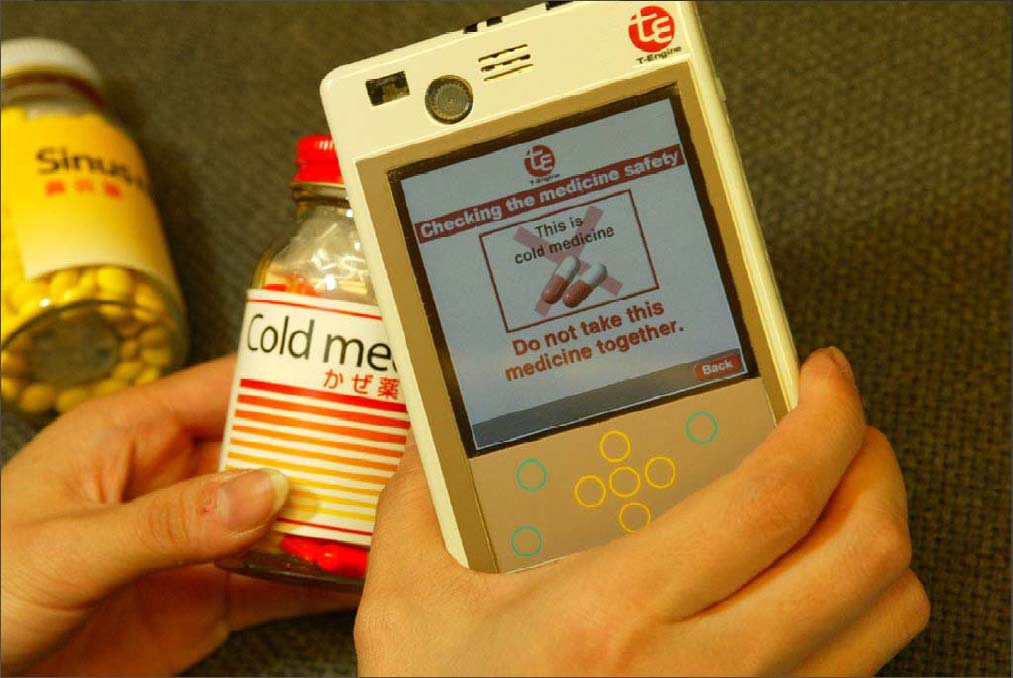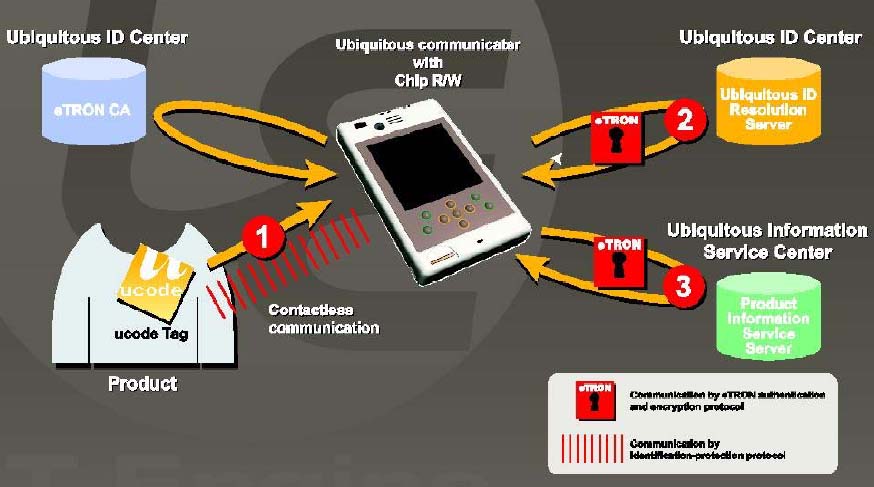


On October 24, at a press conference held at the YRP Ubiquitous Networking Laboratory in Tokyo, Prof. Ken Sakamura, head of the laboratory and chairman of the T-Engine Forum announced the successful development of a new, smaller version of the Ubiquitous Communicator (one-third the size of the previous model) to about 40 members of the press. The PDA-size device, which is based on a specially developed application specific integrated circuit (ASIC) chip, is designed to enable secure communication with things, environments, and people that use the technologies developed at the Ubiquitous Networking Laboratory. In particular, the new Ubiquitous Communicator is able to work with the three types of UNL-approved radio frequency identification chips, the µ-chip, the T-Junction, and the AE45, which were developed by Hitachi Ltd., Toppan Printing Co., Ltd., and Renesas Technology Corporation, respectively. All of these chips have been cleared for use with "ucode," which are the unique ubiquitous identification (uID) numbers that will be determined and recorded at the related Ubiquitous ID Center.
After giving a general rundown on the new, compact Ubiquitous Communicator, Prof. Sakamura proceeded to give a demonstration of it, and he began with one of his favorite examples, which is using the Ubiquitous Communicator to ensure that a patient takes the right medicine and doesn't mix medicines that shouldn't be taken together. The second example in the demonstration was new and startling. The Ubiquitous Communicator read a tag connected to a large daikon, and then using MPEG4 streaming at 30 frames per second presented a video commercial from the farmer who was actually responsible for cultivating the daikon. The Ubiquitous Communicator has impressive multimedia capabilities, being able to handle MPEG4 video and JPEG images. It is also equipped with a built-in CMOS camera, a hands-free microphone/speaker, external video digital input/output, RGB video output, and even a fingerprint sensor. These impressive capabilities were realized thanks to a special ASIC chip, which handles image and encryption processing and is equipped with a video controller and an eTRON interface.
The Ubiquitous Communicator operates on multiple communication bands, specifically, 2.45 GHz, a UHF band that is yet to be decided in Japan, and 13.56 MHz, the latter of which is used for eTRON smart cards. It is also multimodal; using an expansion slot, it can operate in environments based on infrared, Bluetooth, wireless LAN, and PHS communications standards. Prof. Sakamura explained that from the end user's point of view, it can communicate with things to which a ucode has been attached (either RFID or bar core, the latter of which is read with the built-in camera), environments (e.g., a restaurant where menus are beamed via infrared), and people via wireless networks. That, of course, is a description of a "communication machine" as defined early in the TRON Project, and thus Prof. Sakamura is absolutely delighted that it has at last be realized. Of course, the "communication machine" was originally supposed to be a BTRON machine, but that problem could easily be solved by porting Personal Media Corporation's BTRON-based Cho Kanji operating system to the Ubiquitous Communicator. The result would be one of the most impressive PDAs on the market.

There were a couple of other impressive demonstrations at the press conference. Prof. Sakamura showed how using a special sensor, the Ubiquitous Communicator could be used to find out when a plant needs watering. He also gave another streaming demonstration using an RFID tag attached to a retail DVD, which allowed the Ubiquitous Communicator holder to view a short clip from the video. Prof. Sakamura said the Ubiquitous ID Center has recently established a policy that mandates that the location of RFID tags must be made apparent to the consumer, so that the consumer can remove them if he/she so wishes. However, since he would also like to create an intelligent washing machine, which would interact with RFIDs attached to clothing, new conveniences could be afforded to consumers who chose not to do so. For those who are concerned about privacy issues, it is worth noting that Prof. Sakamura actually to had to hunt around a couple of times to find the RFID tags attached to items for the demonstration.
Prof. Sakamura summed up his presentation by saying that all the functions are needed to have fun and also to create a market. Since Japan is at the top of this field, he said he believed that the price of a commercialized Ubiquitous Communicator based on the experimental model he demonstrated could be reduced to the price of a PDA on the Japanese market, which is to say somewhere between 10,000 and 100,000 yen. The hardware specification for the new, compact Ubiquitous Communicator.
| CPU | 32-bit |
| Flash memory | 8 megabytes |
| SDRAM | 32 megabytes |
| Graphic SDRAM | 32 megabytes |
| SD | 2 slots |
| eTRON SIM slot | 1 slot |
| Multiband antenna | 1 internally mounted |
| Fingerprint sensor | 1 sweep type |
| LCD | 320 x 320 dot TFT |
| USB | Host/function |
| External dimensions | 120 mm x 75 mm x 17.2 mm |
| Weight | 175 grams |
During the question and answer session, Prof. Sakamura was asked what would happen if a ucode-based RFID tag user violated the Ubiquitous ID Center's rules by refusing to indicate where the RFID tag was located. He said that hasn't been decided yet, but that there would certainly be a penalty. He was also asked whether it would be possible to add the new functions demonstrated to an existing PDA. Prof. Sakamura said, it is very difficult to add one design to another while maintaining the same form factor, which is not to mention the fact that the Ubiquitous Communicator is based on a real-time operating system. As to when it could possibly hit the market, Prof. Sakamura stated that that would be possible starting next year. He also said there are plans to develop a uID authoring kit that would allow individuals to create their own wireless tags for private use.
There was another big RFID announcement in October. At the same time the TRON Project was unveiling its new, compact Ubiquitous Communicator, Massachusetts Institute of Technology announced that on October 26 it would officially close down the Auto-ID Center, the American equivalent of the Japan's Ubiquitous ID Center. The reason stated was that the project had reached a stage that went beyond basic research and development, but it is well known that RFID tags have drawn an immense amount of criticism in the U.S., where civil libertarians fear the technology will be used as a key technology in the creation of a post 9-11 police state. The Auto-ID project, however, is not going out of existence. The technologies developed at the Auto-ID Center will be referred to EPCglobal, which will administer and develop "electronic product code" standards in the future. The university labs of the former Auto-ID Center will henceforth be referred to as Auto-ID Labs.
Although the Auto-ID and the uID are frequently reported as competing technologies, the goals of each are different, and they can also be made compatible using technological measures. Another difference is that the Auto-ID scheme uses a radio frequency peculiar to North America, which cannot be used in Japan or Europe, since this spectrum has already been allotted for other purposes. However, Prof. Sakamura has pointed out that there is no "frequency battle" with the U.S., since that problem can be fixed technology. Specifically, the frequency problem can be handled by creating dual-band RFID chips.